
Many people aged 30 to 35 complain of back pain.The cause of these pains may be spine disease.Osteochondrosis is a disease that occurs in middle -aged people, but is more often detected in patients after 40 years.
Osteochondrosis - What is this disease and what is your danger?
This term means a dystrophic process of cartilage and subject bone tissue.In modern medical practice, osteochondrosis is called degenerative-distribution disease of the spine and intervertebral discs that play the role of the damper.The danger of the disease is that the affected disc is almost impossible to restore and, without proper treatment, disability is possible.
Is osteochondrosis a common disease?The statistics are not happy.About 85% of the population in the world suffers from this disease.
This disease is the most common form among all diseases that affect the spine.And according to the prevalence, it is immediately after the diseases of the cardiovascular system.
The essence of the disease
So osteochondrosis - What is it?This is a chronic disease that affects the joints, most of the time the spine.
The spine of the spine consists of 24 vertebrae.Between the two vertebrae, there is a disc, whose purpose is the softening and depreciation of the loads.
In normal state, the disc is quite elastic and can support significant loads.In the center of the disc there is a pulp core with lots of water.For some reason, the core loses its hydrophilic properties.
As a result, the disk delays, decreases height and deformation.In later stages, bone tissue growth occurs with the formation of growth - osteophytes that compress the peripheral nerves and the spinal cord.This is what is osteochondrosis of the spine.
The Causes of Pathology
Despite the fact that osteochondrosis is a very common disease, the reasons why the pathology develops is not completely established.

The main factors are considered:
- Excessive column load;
- injuries;
- PROFESSIONAL HARM - Weight survey or extended work in an uncomfortable and immovable pose;
- overweight body weight;
- heredity;
- violation of posture.
Osteochondrosis develops to one degree or another in almost everyone of the elderly and is one of the body's aging processes.
Stages, shapes and symptoms of disease development
Experts distinguish 4 stages of the disease:
- 1st stage- Move the core of the disc to the edge;
- Stage 2- The occurrence of cracks in the cartilage wheels and the instability of the vertebral section;
- Stage 3- a complete disk rupture with the loss of the nucleus in the stem of the spine, while the spinal cord roots are possible;
- 4th stage- Approximate changes not only on the intervertebral disc, but also in surrounding tissues.
The main symptom of the disease is pain.It can be acute with high intensity or moderate and stupid manifestation.
In addition to pain, there are:
- painful tension of the back muscles;
- Skin numbness in arms and legs;
- Limitation of the volume of movements;
- weakness in the muscles of the limbs;
- arms and leg thinning;
- Sudden dizziness.
These are general manifestations for all forms of pathology.Depending on the spine in which changes are located, three forms of the disease with characteristic symptoms are distinguished.
Table nº 1. Osteochondrosis forms and their inherent symptoms:
| Disease form | Symptoms |
| Neck osteochondrosis | Changes in this department lead to pushing blood vessels and impaired microcirculation.For this reason, a person has constant dizziness.Sometimes this leads to weaning.There is a noise in the ears and shaking of colored spots in front of the eyes. |
| Osteochondrosis in thoracic vertebrae | With this form of disease, acute chest pain is observed.The disease can cause intercostal neuralgia progression and aggravate the course of heart pathologies. |
| Osteochondrosis in the lower back | Pathology in the lower back is manifested by pain in the gluteal region, a decrease in IKR tone.A complication can be radiculite, which is accompanied by the pain that spreads through the leg. |
Due to the pathology of vertebral discs, there is a large number of disorders in the body: pinching nerves, swelling, circulatory violation and fibrosis of surrounding tissues.These changes cause a variety of symptoms, which complicates the diagnosis and prescribes proper treatment without carefully examination.
Clinical manifestations
The symptoms of the disease depend on where the injury is mainly located.In the sections below, we consider the characteristic signs of each variety of the disease.
The Cervical Department
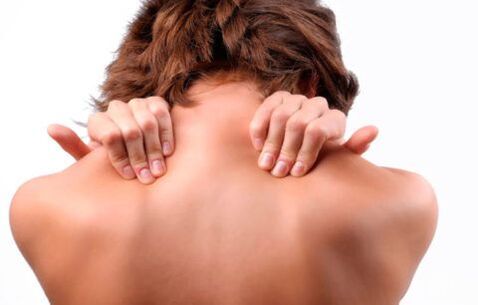
The main symptoms of cervical spine damage include:
- discomfort, neck pain and shoulders;
- muscle hypotonus;
- Increased perspiration;
- numbness of the fingers;
- Violation of Movement Coordination;
- headaches, dizziness;
- Problems with hearing and vision;
- Hypertension.
With the progression of the disease and the damage to the close arteries and nerves, one of the following syndromes can develop:
- vertebral artery;
- cardiac;
- hypertension;
- source;
- Cervical migraine.
The violation of blood circulation in the vertebral artery and this hypoxia of brain tissues are the dangerous consequences of osteochondrosis.
This syndrome manifests itself:
- periodic system/dizziness;
- weakening of vision;
- partial or complete hearing loss;
- Sometimes - faint.
Important!Neurological manifestations of spine osteochondrosis usually need to differentiate with cerebral atherosclerosis, DEP and other pathologies.
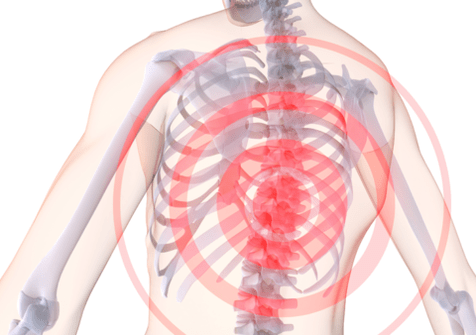
Thoracic region
Compared to other forms of the disease, thoracic osteochondrosis manifests less pronounced.
Among its symptoms:
- chest pain, increasing at night or prolonged in a position;
- discomfort, a feeling of squeezing between the shoulder blades;
- Strengthening pain during deep breathing.
If the disease is not treated, it will progress, causing damage to the next and nerves located nearby.
Signs of the development of complications of spine osteochondrosis of this location can be:
- Skin numbness in some areas, a feeling of "chills" crawling;
- Itching on the skin, burning;
- Cooling of the members;
- fragility of nails;
- pronounced dry skin;
- pain along the esophagus and pharynx;
- Gastrointestinal tract disorders.
In addition, disease chest location is characterized by two specific symptoms - dorsago and dorsalgia.
Dorsago is a sudden, sharp and very intense chest pain, a "chest change."It can occur with prolonged in the same position, monotonous work.
Pay attention!During the chest, the pain is so severe that patients are afraid to do an extra inhalation.
Dorsalgia is less intense, but monotonous painful sensations that can last up to 2-3 weeks.They intensify with deep breathing, inclinations.
Lumbar
Osteochondrosis of the lower spine, namely the lumbar, occupies a leadership position on prevalence.
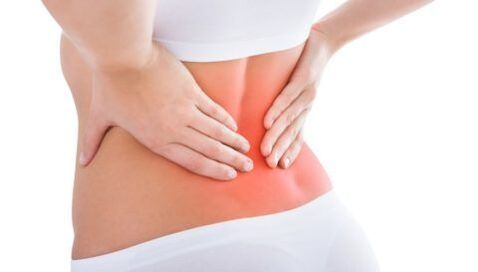
Among its characteristic symptoms:
- Most frequently painful monotonous lumbar pain, radiating in the leg;
- discomfort, intensifying by changing the body position, sneezing, coughing, trying to lift weights;
- constant muscle spasm in the lower back;
- Lights in the lower back;
- impaired sensitivity in the skin of buttocks, hips, legs, feet;
- a feeling of creeping goose bumps at the lower ends;
- Dry, peeling the skin.
The sacral department
Sacral spine osteochondrosis is extremely rare in isolation and is usually a "continuation" of lower lumbar damage.
This explains the characteristics of its symptoms:
- Lumbar pain, as well as in the sealing nerve;
- "Shelters" sharp throughout the leg;
- An unpleasant feeling of discomfort on the back of the thigh;
- dormancy of the lower limb;
- Paresis as well as unstable symptoms of impaired motor activity.
Important!Lower spine osteochondrosis can lead to extremely dangerous complications, such as blood supply impaired to spinal cord and compression myelopathy.
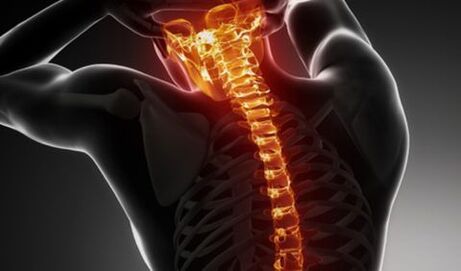
Common osteochondrosis
A common form, or osteochondrosis of all parts of the spine, is the most severe version of the pathology.Due to the vastness of defeat, your image can be extremely diverse and include almost all the symptoms described above.
Diagnostic methods
The appearance of any complaints indicated above requires an appeal to a medical institution: the patient should examine the patient.The diagnosis of osteochondrosis should be complex and very complete.
Standard instruction includes the following stages:
- Complaints and anamnesis collection.
- Clinical inspection.
- X -Ray Exam.
- Modern Methods (CT, MRI).
Conducting a conversation with the patient, the doctor should find out:
- that bothers the patient;
- What is the place of the most pronounced unpleasant sensations;
- What is their intensity and duration;
- that causes its strengthening;
- which helps deal with pain.
Important!Make sure you say to the doctor how long you are concerned about these complaints and if you received any treatment before.

During a clinical inspection, the expert evaluates:
- The position of the patient's body, march, the volume of active and passive movements;
- the presence of skin defects, redness, peeling;
- symmetry of healthy and sick parts of the body;
- the presence of muscle spasm;
- the area of pain irradiation;
- The presence of pain, temperature and other types of sensitivity.
During radiography, each column for better viewing is studied individually.The images are performed live, lateral and (according to indications) of two oblique projections.To evaluate the stage and severity of degenerative-distribution changes, the osteochondros X-ray classification of the Zeaker spine is used.
Table: X -Gramebral spine osteochondrosis stages:
| Internship | Description |
| Me (+) | Changes not expressed in lordosis in a small number of segments |
| II (++) |
|
| III (+++) | Express changes, significant narrowing of intervertebral holes |
| IV (++++) | Significant narrowing of intervertebral holes, massive exostosis, often irreversible changes |
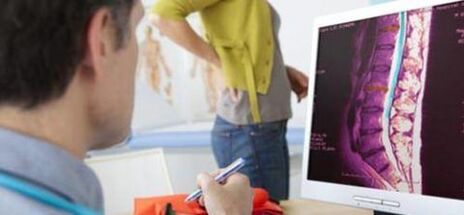
With the insufficient content of ricture R information, the patient can be prescribed more modern tests (images directed from one or more segments of the spine spine) and magnetic resonance imaging (visual diagnostic method based on the properties of electromagnetic radiation).
Treatment
First of all, the doctor explains to the patient what osteochondrosis is and how to treat it.He talks about a set of measures that must be performed for a long time.
The therapy of the disease is performed taking into account the stage.In the initial period of the disease, massage, physical therapy and physical therapy exercises are indicated.But as the dystrophic process advances, several orthopedic devices to immobilize the spine should be used.Drug treatment is also required.
Surgical intervention is indicated with complications and the ineffectiveness of conservative treatment.
Medication
The most important tasks of pharmacological drug treatment are pain relief, eliminating inflammation of nerve roots, restoring cartilage structality, improving blood circulation and nutrition, interrupting pathology development.There are several groups of medicines that can be prescribed in this case.
In pharmacies, they are represented in various ways and in a wide variety.The price of medicines may be different and you can always choose the most affordable.
Table No. 2. Medicines used in conservative osteochondrosis therapy:
| Pharmacological group | Therapeutic effect | Instructions for Use |
| Chondoprotectors | Limiting cartilage degeneration processes contributes to its restoration. | Take 1 capsule for a month.If necessary, the course of treatment is repeated. |
| Aine | It has an anesthetic effect, reduces the inflammatory process. | Take a tablet for pain.With intense pain, intramuscular injections of the drug are used. |
| Vitamins B. | Improves nerve impulse conductivity, restores microcirculation in the affected cartilage area. | The course of treatment with intramuscular injections is performed. |
| Muselaxantes | Relax the muscles, relieves tension, facilitates pain. | Take a tablet 2 times a day. |
Medicines are prescribed according to the doctor's testimony.Self -duty may be ineffective and, in some cases, even damage.
Physiotherapy for osteochondrosis
What to do with osteochondrosis, except medication, accelerate recovery?One of the most effective treatment methods of this disease is physiotherapy.
Its advantage is a selective effect on the focus of the disease.Physiotherapy contributions to reduce pain, elimination of inflammation and increase general immunity.With their help, the muscles relax, metabolic processes and blood circulation are normalized.
For osteochondrosis, they are used successfully:
- Magnetotherapy;
- laser therapy;
- Shock wave therapy;
- quartz;
- electrophoresis;
- The effect of low frequency electrical currents.
Physiotherapy does not perform if the patient is in serious condition, with an exacerbation of the disease, cancer diseases and mental disorders.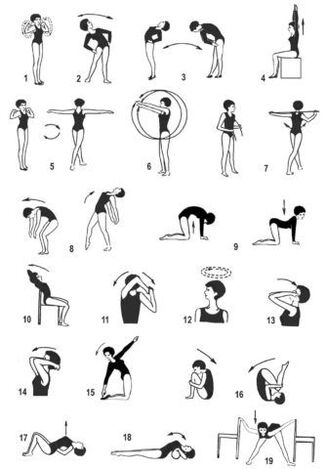 In other cases, physiotherapy has a beneficial effect on the recovery process, increases the effect of drugs, which reduces their dose.
In other cases, physiotherapy has a beneficial effect on the recovery process, increases the effect of drugs, which reduces their dose.
Medical Physical Education
Physical education classes are prohibited in the acute period of the disease.After eliminating this period, the doctor prescribes therapeutic exercises, which he develops along with the instructor individually for each patient.
With the help of the exercises, muscle corset is strengthened, which prevents the curvature of the spine and allows you to properly and evenly distribute the load on the vertebrae.With regular physical exertion, medicinal substances penetrate the spine at higher concentrations than in their absence.
It is necessary to engage in the guidance of an experienced instructor and carefully monitor his condition.With discomfort and intense pain, exercise should be interrupted.
Prevention
Knowing what osteochondrosis and its consequences are, it will be useful to think about prevention.
Preventive measures are quite simple, they are easy to perform for everyone who cares about their health:
- injury prevention;
- Regular physical training (swimming is very useful);
- maintain normal weight;
- Do not carry the column;
- Monitor posture correction;
- not being in a position for a long time;
- Avoid sudden movements by lifting weights.
In complying with these rules, the period of remission will be long.
Osteochondrosis is a very serious disease.But with the timely search of a doctor and proper treatment, it is possible to prevent its destructive effect.
Questions for the doctor
Neck
Hello, say you, please.I'm 24 years old.In the last two months, neck pain, the back of the head (sometimes still gives the whiskey, eyes).I also notice a strong crisis in the neck, tingling and numbness of the hands, tongue and sky.
I suspect that osteochondrosis, because the mother and grandmother of youth are tormented with similar symptoms.Where to start the exam?And another question: Can I go to the aerobic?
Make an R-Scheme (CT) store and Doppler of the head and neck ships.You have probably developed vertebral artery syndrome in relation to the bottom of cervical osteochondrosis.An additional plan for diagnosis and treatment can only be prepared after obtaining the results of these tests.
It is better not to visit the aerobic yet.
Lumbar osteochondrosis
For seven years, I was tormented with the lower back, the exacerbation of osteochondrosis is almost every 2-3 months.Injections and tablets help for a short time and then the pain returns.I work as a postman, it gets harder.Is I placed deficiency?
Hello!The decision on the granting of the disabled group is made by UIT based on a comprehensive study of its situation.First, you need to contact the therapist and undergo an exam.
As a rule, with lumbar osteochondrosis, a disability group is not shown.Its prize is possible with the development of complications (protrusions, intervertebral hernias, etc.).But again, I repeat, everything is individual here.

























